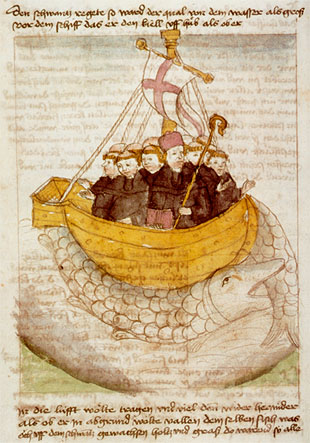Wednesday, 16 May 2012
16 May circa 583 AD: Saint Brendan of Clonfert/Brénainn of Cluain Ferta aka 'St. Brendan the Navigator', early Atlantic voyager, died on this day. In the liturgical calendar, today is St. Brendan's Feast Day.
Saint Brendan/Bréanainn is one of Ireland's most famous saints, a man whose exploits on the High Seas have become legendary and whose fame spread throughout western Europe in the Middle Ages. He is reputed to have sailed far out into the Atlantic and discovered isles unknown to Europeans at that time. The Brendan Voyage/Navigatio Brendani was included in maps of Columbus’ time, which often showed an island called 'St. Brendan’s Isle' that was placed in the western Atlantic ocean.
Map makers of the time had no idea of its exact position of this island but did believe it existed somewhere out in the Atlantic. It was mentioned in a Latin text dating from the ninth century called Navigatio Santi Brendani Abatis (Voyage of Saint Brendan the Abbot). It described the voyage as having taken place in the sixth century. Several copies of this text have survived in monasteries throughout Europe. It was an important part of folklore in medieval Europe and may have influenced Columbus when he planned his great voyage to the Indies.
The account of Brendan’s voyage contained a detailed description of the construction of his boat which was not unlike the currachs still made in Ireland today.
Skeptics could not accept that such a fragile vessel could possibly sail in the open sea. Several passages in the legend also seemed incredible—they were “raised up on the back of sea monsters”, they “passed by crystals that rose up to the sky”, and they were “pelted with flaming, foul-smelling rocks by the inhabitants of a large island on their route”.
Brendan and his companions finally arrived at the beautiful land they called “Promised Land of the Saints.” They explored until they came to a great river that divided the land. The journey of Brendan and his fellow monks took seven years. The return trip was probably the longest part of the odyssey.
The evidence that we have points to Brendan sailing North, possibly along the western coast of Scotland and onto Iceland and maybe as far as Greenland.
It is a story full of wonderful and strange adventures that while physically improbale in the way they have been handed down to us have enough information in them to point to actual happenings embelished by later medieval storytelling.
It is a story full of wonderful and strange adventures that while physically improbale in the way they have been handed down to us have enough information in them to point to actual happenings embelished by later medieval storytelling.
In the 1970's the Explorer Tim Sevrin embarked in a specially built Currach based on tehe one described as used by Saint Brendan and proved that it could survive a long sea voyage on the Atlantic.
He encountered whales who swam alongside and even underneath his ship. Saint Brendan's Voyage described the ancient mariners landing on a whale!
Sevrin encountered icebergs - St Brendan saw 'towering crystals'
The foul smelling rocks could well be from an Icelandic volcano that the poor monks thought was been thrown at them by the 'natives' of that fiery island!
St Brendan while one of the most famous of Irish Saints both at home and abroad is also one whose Life we can only reconstruct from the tales and legends about him. His fame meant that many Abbies and monastries wanted his name associated with him and which ones would (if it were possible) hold up to examination and which would not we now alas cannot determine.
St. Brendan,The Navigator - World Cultures European
Subscribe to:
Post Comments (Atom)

Terrific Blog,Very informative.Keep up the good work!
ReplyDelete